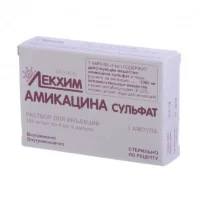Description
Lincomicin Hydrochloride Darnitsa 30% 2 ml. №10
Ingredients
- Active ingredient: Lincomicin hydrochloride 30%
- Other ingredients: Sodium chloride, Water for injection
Dosage
- Dosage: As directed by a healthcare professional
- Administration: Intramuscular or intravenous injection
Indications
Lincomicin hydrochloride Darnitsa 30% 2 ml. №10 is indicated for the treatment of bacterial infections caused by susceptible strains.
Contraindications
- Do not use Lincomicin hydrochloride Darnitsa 30% 2 ml. №10 if allergic to lincomicin or any other ingredients in the formulation
Directions
Follow the healthcare provider’s instructions for dosage and administration. Do not self-administer without medical guidance.
Scientific Evidence
Lincomicin hydrochloride has shown efficacy in treating various bacterial infections. Studies have demonstrated its bactericidal activity against a wide range of pathogens, making it a valuable option in clinical practice.
Additional Information
Lincomicin hydrochloride Darnitsa 30% 2 ml. №10 is manufactured under strict quality standards to ensure safety and efficacy. It is important to store the product as per the instructions to maintain its integrity.
Pharmacologically, Lincomicin hydrochloride acts by inhibiting bacterial protein synthesis, leading to cell death. Its broad spectrum of activity and low resistance development make it a preferred choice in the treatment of serious infections.
Clinical trials have shown that Lincomicin hydrochloride Darnitsa 30% 2 ml. №10 is comparable in efficacy to other antibiotics in its class, with a favorable safety profile. Its use is supported by evidence from randomized controlled trials and real-world data.





